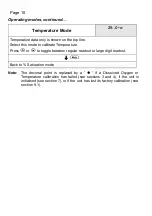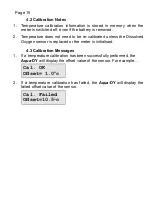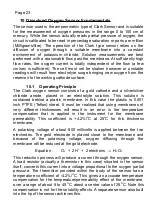
10. Dissolved Oxygen Sensor Fundamentals
The sensor used is the amperometric type of Clark Sensor and is suitable
for the measurement of oxygen pressures in the range 0 to 100 cm of
mercury. While the sensor actually reads partial pressure of oxygen, the
circuit is calibrated to be read in percentage saturation or parts per million
(Milligrams/litre). The operation of the Clark type sensor relies on the
diffusion of oxygen through a suitable membrane into a constant
environment of potassium chloride. Solution measurements are best
performed with a reasonable flow past the membrane. At sufficiently high
flow rates, the oxygen current is totally independent of the flow (a few
cm/sec is sufficient). The cell must not be shaken however or unstable
readings will result from electrolyte surge bringing new oxygen from the
reservoir to the working cathode surface.
10.1
Operating Principle
The Clark oxygen sensor consists of a gold cathode and a silver/silver
chloride anode, placed in an electrolyte solution. This solution is
contained behind a plastic membrane. In this case the plastic is 0.001
inch PTFE (Teflon) sheet. It must be realised that using membranes of
very different thicknesses will result in an error in the temperature
compensation that is applied in the instrument for the membrane
permeability. This coefficient is +4.2%/
o
C at 25
o
C for this thickness
membrane.
A polarising voltage of about 800 millivolts is applied between the two
electrodes. The gold electrode is placed close to the membrane and
because of the polarising voltage, oxygen diffusing through the
membrane will be reduced at the gold electrode.
Equation :
O
2
+ 2H
+
+ 2 electrons
�
H
2
O
2
This reduction process will produce a current through the oxygen sensor.
A load resistor (actually a thermistor in this case) situated in the sensor
itself, converts this current into a voltage proportional to the oxygen partial
pressure. The thermistor provided within the body of the sensor has a
temperature coefficient of -4.2%/
O
C. This gives an accurate temperature
compensation for the temperature/permeability effect of the membrane,
over a range of about 5 to 45
O
C about a centre value of 25
O
C. Note this
compensation is not for the solubility effects. A separate sensor also built
into the tip of the sensor achieves this.
Page 23





































